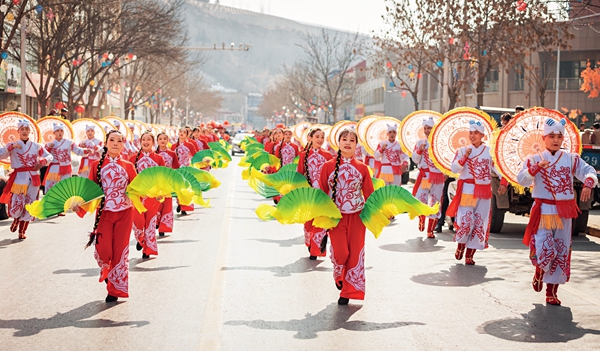Joyful Yangko Dance Delivers Happiness, Creates Festive Atmosphere

Yangko is a traditional, rural folk dance mainly prevalent in northern China. Yangko is smooth, happy and compact in rhythm, and it features jolly scenes, vibrant and energetic postures, and a vivid performance style. Therefore, people often perform Yangko during festivals and special celebrations. In 2006, Yangko was added to the list of items of national intangible cultural heritage.
Yangko, which dates back nearly 1,000 years, originated from farm work, such as plowing farmland and transplanting rice seedlings. It was also derived from the songs ancestors performed when they worshiped the god of farming, to pray for a good harvest. Over time, Yangko absorbed folk songs and the techniques and forms of acrobatics and martial arts, and it eventually developed into an art form that combines song and dance.


Yangko thrived, and it became hugely popular during the Ming (1368-1644) and Qing (1616-1911) dynasties. The dance, deeply rooted in rural traditions and customs, emerged as an important Chinese cultural symbol, and as a celebration of rural heritage. Nowadays, Yangko dance is not only a popular tradition in rural areas, it is also performed during festivals and cultural activities in urban areas. There are two types of Yangko performance: Yangko performed on the ground, also called ground Yangko, and Yangko performed on stilts. A Yangko performance is a form of entertainment; it captivates the audience, with contagious energy, and it is a source of joy and vitality for viewers.
A Yangko dance does not have a fixed number of performers; there can be two or three, several dozen, or even more than 100 dancers. The performers, whether women or men, wear bright, colorful costumes, and they dance to the rhythm of a gong, drum, small cymbals, suona horn (a woodwind instrument), and/or other folk instruments.
Given the differences in cultures and customs in various regions of China, variations exist in Yangko from region to region. Dance styles, techniques and movements vary, meaning Yangko dance in each region has distinct features.


Ground Yangko in Fushun, home of the Manchu ethnic group and a city in northeast China's Liaoning Province, is representative of the Yangko dances in northeastern China. Fushun's ground Yangko, which dates back to the early Qing Dynasty, features vigorous and robust performances, which highlight the bravery of the Manchu people.
Performers usually wear traditional Manchu clothes, and they perform dance movements — such as jumping upon a horse and shooting an arrow — that imitate fishing, hunting and fighting. They also imitate animals, including eagles, tigers and bears. Yangko, which reflects the production and lifestyle of Manchu people's ancestors, has become an important carrier of ethnic Manchu's traditional folk culture.
Yangko is also popular in Yulin and Yan'an, cities in northwest China's Shaanxi Province. Yangko in Suide, a county in Yulin, is most representative of the Yangko dances in northern Shaanxi. During a typical Suide Yangko performance, there are several dozen performers. In some cases, there are nearly 100 dancers. Santou is the lead performer in this form of Yangko, and the person generally holds an umbrella. Santou must excel at singing local folk songs, and at improvising new song lyrics when situations require. Led by santou, performers dance to the rhythm of gongs, drums and suona horns. They jump, twist, swing their arms, and sway back and forth, from left to right. The performers and viewers are immersed in a happy, joyful atmosphere.


Changli Ground Yangko is popular in Luanzhou City and the counties of Changli, Lulong, Funing and Laoting, in north China's Hebei Province. This style of Yangko, which dates back to the Yuan Dynasty (1206-1368), was influenced by ethnic Mongolian culture. The hat worn by chou, a clownish male role in the Yangko dance, was derived from traditional Mongolian fashion.
Roles performed during Changli Ground Yangge include niu (girl or young married woman), chou, gongzi (young man), and kuai (middle-aged or elderly woman). The most interesting role is chou, because the character is charmingly naive, kind, humorous, and optimistic, making the audience burst into laughter from time to time.
Jiaozhou Yangko is one of the three styles of Yangko in east China's Shandong Province. The dance originated in Dongxiaotun, a village in Jiaozhou, a city in Shandong, during the late Qing Dynasty. During a Yangko dance, the performers are divided into five roles — xiaoman (girl), shannü (young woman), cuihua (middle-aged or elderly woman), bangchui (young man), and guzi (elderly man). Each role has an even number of performers.
Jiaozhou Yangko emphasizes the charm of women, and the movements of the women performers are full of strength and flexibility, which shows the attractive characteristics of local women. Numerous women inheritors of Jiaozhou Yangko, at all levels, have done their best to promote the inheritance and development of the art form, and to help people learn about the dance.
"The Yangko dance helps me find confidence. Thanks to it, my life is full of positive energy. I want to help more people love Jiaozhou Yangko, and I want to teach them how to perform the dance. We feel joy when we dance, and we hope to deliver happiness to the audience," says Tang Shumin, a city-level inheritor of Jiaozhou Yangko.
Photos from Shen Haibin and VCG
(Women of China English Monthly October 2024)
Editor: Wang Shasha
Please understand that womenofchina.cn,a non-profit, information-communication website, cannot reach every writer before using articles and images. For copyright issues, please contact us by emailing: website@womenofchina.cn. The articles published and opinions expressed on this website represent the opinions of writers and are not necessarily shared by womenofchina.cn.






.jpg)

 WeChat
WeChat Weibo
Weibo 京公网安备 11010102004314号
京公网安备 11010102004314号